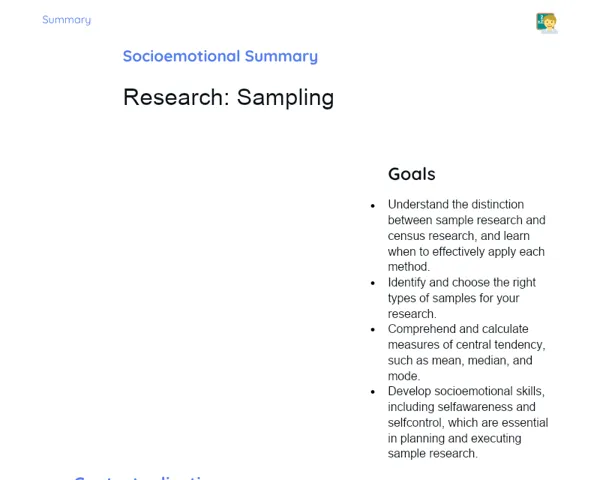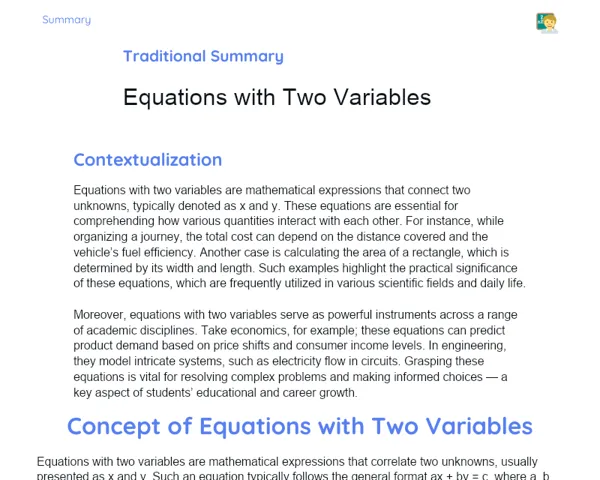Summary Tradisional | Rotations of Plane Figures
Contextualization
Rotation is a key geometric transformation that involves turning a figure around a fixed point, referred to as the center of rotation. This concept is vital in geometry as it enables us to understand how figures can be altered and viewed from various perspectives. For instance, when we rotate a triangle around its center, the vertices shift positions, yet the shape and size of the triangle remain unchanged. This understanding is crucial for grasping symmetry and congruence in geometric shapes.
In the framework of 7th-grade mathematics, learning about rotation helps students cultivate essential skills such as spatial visualization and comprehending the properties of flat figures. Moreover, rotation has real-world applications, notably in fields like engineering, where it is pivotal in designing mechanical parts, and in computer graphics, where animations and games utilize rotations to generate realistic visual effects. Grasping how flat figures, especially triangles, rotate equips students to handle more complex geometry problems and concepts across different subjects.
To Remember!
Definition of Rotation
Rotation is a geometric transformation that involves turning a figure around a fixed point known as the center of rotation. This point can be positioned inside the figure, at one of its vertices, or even outside it. During rotation, the figure keeps its original properties such as shape and size, though its orientation changes based on the angle of rotation. For example, rotating a triangle by 90 degrees causes each vertex to move along a 90-degree arc around the center of rotation, giving the triangle a new position.
This concept is key for understanding how figures can be manipulated and viewed from diverse angles. In addition, rotation stands as one of the three fundamental isometric transformations alongside translation and reflection, which maintain the distances and angles of the original figure.
In 7th-grade mathematics, rotation plays an instrumental role in helping students sharpen their skills in spatial visualization and understanding the characteristics of flat figures, thereby paving the way for dealing with more intricate geometry problems.
-
Rotation involves turning a figure around a fixed point.
-
The figure maintains its original properties, such as shape and size.
-
Rotation is one of the three basic isometric transformations.
Rotation Angles
Rotation angles determine how much a figure turns around the center of rotation. The most common angles of rotation used are 90 degrees, 180 degrees, and 270 degrees, but any angle can be used based on the requirements. Each rotation angle results in a new orientation of the figure while retaining its intrinsic properties.
For instance, rotating a figure by 90 degrees causes each point to move along a 90-degree arc around the center of rotation. This motion is akin to the hands of a clock, where a 90-degree turn in the clockwise direction results in a new position. Likewise, a 180-degree rotation flips the orientation of the figure, and a 270-degree rotation is equal to a 90-degree turn in the counterclockwise direction.
Comprehending different rotation angles is crucial for accurately manipulating figures in geometric problems, allowing students to visualize and solve questions correctly.
-
Rotation angles determine the amount of turn.
-
Common angles: 90 degrees, 180 degrees, and 270 degrees.
-
Each angle results in a new orientation of the figure.
Rotating a Triangle
Rotating a triangle means moving each of its vertices along a specific arc around the center of rotation. For a 90-degree rotation, for instance, each vertex of the triangle moves along a 90-degree arc, leading to new positions for the vertices and consequently for the triangle itself.
To effectively perform this rotation, it is essential to first locate the center of rotation, which might be a point inside the triangle, one of its vertices, or a point outside the figure. Tools including a ruler and compass should be employed to ensure that each vertex accurately follows the designated arc.
Once the rotation is completed, the triangle preserves its original properties like side lengths and the measures of its internal angles, but its orientation is modified. This process is fundamental for understanding how figures can be manipulated and perceived from various angles and is a significant skill in geometric problems.
-
Rotating a triangle involves moving its vertices along a specific arc.
-
Identifying the center of rotation is crucial for accuracy.
-
The triangle retains its original properties, but its orientation changes.
Symmetrical Figures After Rotation
The symmetry of a figure post-rotation hinges on its shape and the angle of rotation applied. Some figures, such as squares and circles, keep their symmetry after certain rotations, while others may adopt new orientations that still retain symmetry.
For example, rotating a square by 90 degrees, 180 degrees, or 270 degrees results in a figure that remains a square and upholds its symmetrical attributes. Similarly, a circle remains unchanged, irrespective of the angle of rotation, due to its infinite symmetry.
Recognizing symmetrical figures after rotation is a vital skill for understanding geometric properties and tackling problems involving transformations. This ability allows students to confirm the accuracy of their rotations and ensure that the resulting figure maintains or alters its symmetry as anticipated.
-
Symmetry after rotation depends on the shape of the figure and the angle of rotation.
-
Figures like squares and circles retain their symmetry after specific rotations.
-
Identifying symmetrical figures is crucial for solving geometric problems.
Key Terms
-
Rotation: A geometric transformation that turns a figure around a fixed point.
-
Center of Rotation: The fixed point around which a figure is turned during a rotation.
-
Angle of Rotation: The amount of turn applied to a figure around the center of rotation.
-
Symmetry: A property of a figure that maintains its shape and proportions after a transformation.
-
Triangle: A flat geometric figure with three sides and three angles.
-
Isometric Transformation: A transformation that preserves the distances and angles of the original figure.
Important Conclusions
In this lesson, we delved into the concept of rotation of flat figures, focusing particularly on how to rotate a triangle through various angles, including 90 degrees, 180 degrees, and 270 degrees. We came to understand that rotation is a geometric transformation that turns a figure around a fixed point known as the center of rotation while preserving its original attributes such as shape and size.
We also discussed the significance of identifying symmetrical figures after rotation and how this skill enables us to verify the accuracy of transformations carried out. Mastering these rotations is foundational for developing spatial visualization skills and effectively solving geometric problems, thereby preparing students for more challenging tasks in mathematics and other fields that utilize geometric concepts.
Furthermore, we highlighted the practical relevance of rotations in various everyday sectors, such as engineering and computer graphics. These applications underline the topic's significance, motivating students to delve deeper into this subject and apply their acquired knowledge in practical scenarios.
Study Tips
-
Practice rotating different geometric figures using graph paper and drawing tools like a ruler and compass to enhance your visualization of the transformations.
-
Leverage online dynamic geometry software to experiment with rotations and other geometric transformations, observing how different angles affect the results.
-
Review the concepts of rotation, center of rotation, and angle of rotation, and create your own examples and problems to solve, reinforcing understanding and clarifying any doubts.



